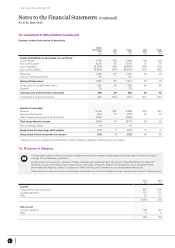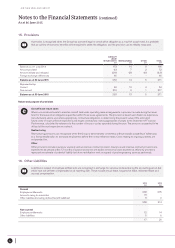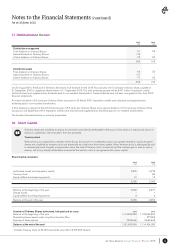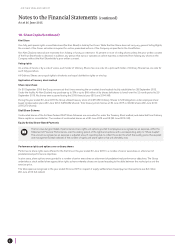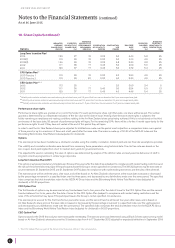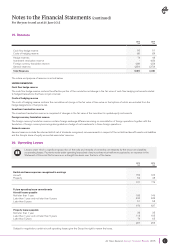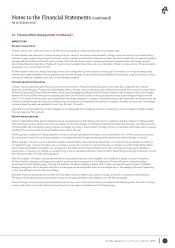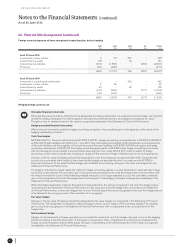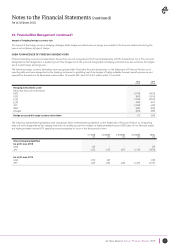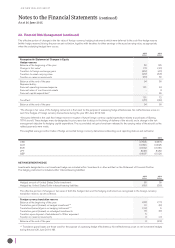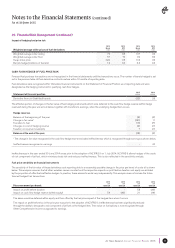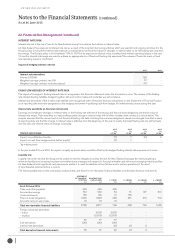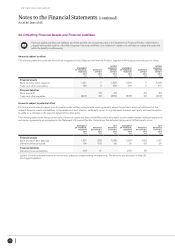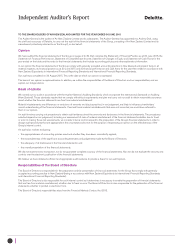Air New Zealand 2015 Annual Report Download - page 32
Download and view the complete annual report
Please find page 32 of the 2015 Air New Zealand annual report below. You can navigate through the pages in the report by either clicking on the pages listed below, or by using the keyword search tool below to find specific information within the annual report.
AIR NEW ZEALAND GROUP
Notes to the Financial Statements (continued)
As at 30 June 2015
30
23. Financial Risk Management (continued)
Foreign currency exposure of items recognised at reporting date, before hedging
NZD
$M
USD
$M
AUD
$M
JPY
$M
TOTAL
$M
As at 30 June 2015
Investments in other entities
Interest-bearing assets
Interest-bearing liabilities
Provisions
2
105
(514)
(29)
63
-
(1,558)
(242)
360
36
-
-
-
-
(250)
-
425
141
(2,322)
(271)
(436) (1,737) 396 (250) (2,027)
As at 30 June 2014
Investment in quoted equity instruments
Investments in other entities
Interest-bearing assets
Interest-bearing liabilities
Provisions
-
2
90
( 611)
(31)
-
46
-
(905)
(165)
422
-
35
-
-
-
-
-
(217)
-
422
48
125
(1,733)
(196)
(550) (1,024) 457 (217) (1,334)
Hedging foreign currency risk
Derivative financial instruments
Derivative financial instruments, other than those designated as hedging instruments in a qualifying cash flow hedge, are classified
as held for trading. Subsequent to initial recognition, derivative financial instruments in this category are stated at fair value.
The gain or loss on remeasurement to fair value is recognised immediately in the Statement of Financial Performance.
Hedge accounted financial instruments
Where financial instruments qualify for hedge accounting, recognition of any resultant gain or loss depends on the nature of the
hedging relationship, as follows:
Cash flow hedges
NZ IFRS 9 (2010) – Financial Instruments and NZ IFRS 9 (2013) – Hedge Accounting and amendments to NZ IFRS 9, NZ IFRS 7
and NZ IAS 39 were adopted with effect from 1 July 2014. They add requirements related to the classification and measurement
of financial liabilities, and derecognition of financial assets and financial liabilities to NZ IFRS 9 (2009) and replace the hedge
accounting requirements of NZ IAS 39. The hedge accounting requirements in NZ IFRS 9 align hedge accounting more closely
with risk management and establish a more principles-base approach than under NZ IAS 39. In order to qualify for hedge
accounting, certain criteria must be met, including an analysis of the sources of hedge ineffectiveness for accounting purposes.
Changes in the fair value of hedging instruments designated as cash flow hedges are recognised within Other Comprehensive
Income and accumulated within equity to the extent that the hedges are deemed effective in accordance with NZ IFRS 9 –
Financial Instruments. To the extent that the hedges are ineffective for accounting, changes in fair value are recognised in the
Statement of Financial Performance.
If a hedging instrument no longer meets the criteria for hedge accounting, expires or is sold, terminated or exercised, then hedge
accounting is discontinued. The cumulative gain or loss previously recognised in the cash flow hedge reserve remains there until
the forecast transaction occurs. If the underlying hedged transaction is no longer expected to occur, the cumulative, unrealised
gain or loss recognised in the cash flow hedge reserve with respect to the hedging instrument is recognised immediately in the
Statement of Financial Performance.
Where the hedge relationship continues throughout its designated term, the amount recognised in the cash flow hedge reserve
is transferred to the Statement of Financial Performance in the same period that the hedged item is recorded in the Statement
of Financial Performance, or when the hedged item is a non-financial asset, the amount recognised in the cash flow hedge reserve
is transferred to the carrying amount of the asset when it is recognised.
Fair value hedges
Changes in the fair value of hedging instruments designated as fair value hedges are recognised in the Statement of Financial
Performance. The hedged item is adjusted to reflect changes in its fair value in respect of the risk being hedged. The resulting
gain or loss is also recognised in the Statement of Financial Performance with an adjustment to the carrying amount of the
hedged item.
Net investment hedge
Hedges of net investments in foreign operations are accounted for similarly to cash flow hedges. Any gain or loss on the hedging
instrument relating to the effective portion of the hedge is recognised in other comprehensive income and accumulated in the
foreign currency translation reserve within equity. The gain or loss relating to the ineffective portion of the hedge is recognised
immediately in the Statement of Financial Performance.


